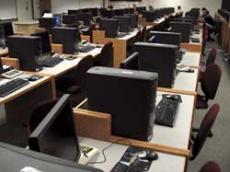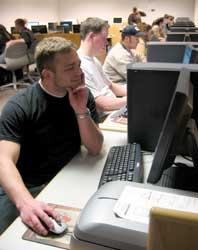Resolution ‘far from being a done deal’
Plans have not yet been finalized for the expansion of the Taggart Student Center computer lab, said Gary Chambers, associate vice president for Student Services and director of the TSC.
A resolution to expand the computer lab was passed by the Associated Students of Utah State University Feb. 28 to keep up with the increasing number of students using it. Quinn Millet, ASUSU president, said at the time the resolution was passed it was part of a movement to make the TSC more student-friendly. Chambers said the idea of the movement has been passed on for several years to each new group of student officers.
“It’s part of the effort of student officers to get the most space to serve the most students in the most ways,” Chambers said. “The spirit of the discussion is, ‘What can we do to make [the TSC] more of a student-centered place?'”
The resolution is far from being a done deal, Chambers said. It now has to go to the student center policy board, which is made up of representatives from student government, faculty, staff, alumni and administration, in mid-April. However, the policy board is only authorized to give input, not make final decisions. After approval or disapproval by the policy board, it will go to the President’s Committee.
Millet originated the resolution, but could not be reached for comment on the next steps.
Chambers said the history of this movement goes back to when student services such as admissions, registration and financial aid were housed in Old Main. In 1985, there was a fire in Old Main, which Chambers said left the school with three options: renovate Old Main and put the offices back where they were before, build a separate student services building or locate the student service offices in the student center.
Chambers said the TSC was made into a “one-stop shop” in response to students’ preference for one building where they could go to take care of all the things they needed to.
The building had to be expanded to make room for the offices. Chambers said the southwest portion of the building is the newer part, the dividing line being a row of columns in the Sunburst Lounge.
The building used to house a lot more student-centered facilities, including a game room where The Utah Statesman office is now, and a bowling alley. However, Chambers said over the years, student services has grown and the TSC’s function as a student activity center has decreased.
“A couple of years ago, there was interest by students to get more space back in for student use,” he said. This began a push to make the TSC a place for students again.
In 1998, the Ballroom was expanded, Chambers said, and the computer lab was moved to its current location. It was previously located on the second floor in the northeast corner, which is now a student TV lounge.
The Juniper Lounge on the second floor used to be offices and is now often full of students relaxing and doing homework. The ASUSU booth on the first floor by the bookstore is a new addition within the last year for student officers to use.
Besides these past changes to the building, others are in the works, Chambers said.
“Several things are impacting all at once right now,” he said.
The expansion of the computer lab is another part of the movement to make the building a better place for students, Chambers said. He said with the new student center by the Eccles Science Learning Center opening in the fall, the dynamics of the building will change. There will be more than 500 beds available in the new residence hall, and the students living there will be coming to the TSC to eat and do homework. An expanded computer lab, and possibly keeping the lab open 24 hours a day, would better suit students’ need, Chambers said.
“Your generation doesn’t seem too affected by the clock,” he said, laughing.
In anticipation of the new demands, Carousel Court will be renovated over the summer to become a meal plan option, Chambers said, and there has been talk of making the Walnut Room into an overflow room for the new dining hall.
The Walnut Room is often used for banquets and activities which will not be able to be held there if it is used as overflow. The loss of that function will be replaced by the addition of a retractable divider in the ballroom that will allow it to accommodate two activities at once.
With the possible expansion of the computer lab is an expansion of the QuickStop. Also, Chambers said the Skyroom may be “taking on a different function and look.”
The problem in the TSC is it is prime real estate. Part of the reason for expanding the TSC computer lab instead of others on campus is because it’s the most popular. Discussion of moving it out of the TSC did not go far, Chambers said, because it would serve students better where it is.
Also, Associate Director of Network and Computing Services Bob Bayn said it has a high turnover rate. There is a lot of foot traffic going through the first floor, he said, and the location of the lab is convenient.
Lots of other offices and services could make a claim on the building, as well, but there just isn’t enough room, Chambers said.
“If we wanted to be everything to everybody, I don’t think it can happen with the current square footage,” he said. “Down the road, we may need an expansion.”
The TSC has 236,000 square feet, according to Chambers. About 100,000 square feet of that is hallways, bathrooms and lounges, leaving about 130,000 square feet of “assignable” space that could be made into offices, he said.
Long term, Chambers says the future of computer labs is uncertain, as more and more students bring computers to school. Bayn said card-swipe numbers have dropped by about 30,000 a month with the closing of the old library and the opening of the Information Commons in the Merrill-Cazier Library, which doesn’t swipe cards.
However, Chambers said there are two reasons labs will probably remain vital to campus: they are convenient and they are constantly upgraded. Part of student fees goes to the computer labs to pay for frequent software upgrades and hardware replacements every three years, he said.
In order to expand the computer lab, it would have to take space currently housing the Statesman offices. Newspaper employees were alarmed by the possibility of being moved out of the building, as there doesn’t seem to be any place else in the TSC to go.
Chambers jokingly suggested taking a walk around the building to find a free spot. He said the student TV lounge on the second floor would be an option.
Besides housing only computers, Chambers said computing services has been considering incorporating study tables in the lab in a way similar to the set up in the new library.
-ella@cc.usu.edu

Empty computer labs around campus could be one hiccup in the resolution’s progress and may deter some from approving the legislation.

